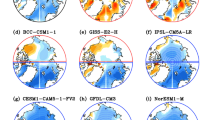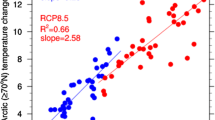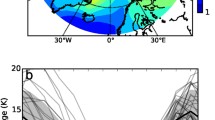Abstract
The finding that surface warming over the Arctic exceeds that over the rest of the world under global warming is a robust feature among general circulation models (GCMs). While various mechanisms have been proposed, quantifying their relative contributions is an important task in order to understand model behavior. Here we apply a recently proposed feedback analysis technique to an atmosphere–ocean GCM under two and four times CO2 concentrations which approximately lead to seasonally and annually sea ice-free climates. The contribution of feedbacks to Arctic temperature change is investigated. The surface warming in the Arctic is contributed by albedo, water vapour and large-scale condensation feedbacks and reduced by the evaporative cooling feedback. The surface warming contrast between the Arctic and the global averages (AA) is maintained by albedo and evaporative cooling feedbacks. The latter contributes to AA predominantly by cooling the low latitudes more than the Arctic. Latent heat transport into the Arctic increases and hence evaporative cooling plus large-scale condensation feedback contributes positively to AA. On the other hand, dry-static energy transport into the Arctic decreases and hence dynamical heating feedback contributes negatively to AA. An important contribution is thus made via changes in hydrological cycle and not via the ‘dry’ heat transport process. A larger response near the surface than aloft in the Arctic is maintained by the albedo, water vapour, and dynamical heating feedbacks, in which the albedo and water vapour feedbacks contribute through warming the surface more than aloft, and the dynamical heating feedback contributes by cooling aloft more than the surface. In our experiments, ocean and sea ice dynamics play a secondary role. It is shown that a different level of CO2 increase introduces a latitudinal and seasonal difference into the feedbacks.














Similar content being viewed by others
References
Alexeev VA, Langen PL, Bates JR (2005) Polar amplification of surface warming on an aquaplanet in “ghost forcing” experiments without sea ice feedbacks. Clim Dyn 24:655–666
Alexeev VA, Esau I, Polyakov IV, Byam SJ, Sorokina S (2011) Vertical structure of recent arctic warming from observed data and reanalysis products. Clim Chan 111:215–239
Andrews T, Ringer MA, Doutriaux-Boucher M, Webb MJ, Collins WJ (2012) Sensitivity of an Earth system climate model to idealized radiative forcing. Geophys Res Lett 39:L10702. doi:10.1029/2012gl051942
Bintanja R, Graversen RG, Hazeleger W (2011) Arctic winter warming amplified by the thermal inversion and consequent low infrared cooling to space. Nat Geosci 4:758–761
Bintanja R, van der Linden EC, Hazeleger W (2012) Boundary layer stability and Arctic climate change: a feedback study using EC-Earth. Clim Dyn 39:2659–2673
Boé J, Hall A, Qu X (2009) Current GCMs’ unrealistic negative feedback in the arctic. J Clim 22:4682–4695
Cai M (2005) Dynamical amplification of polar warming. Geophys Res Lett 32:L22710. doi:10.1029/2005gl024481
Cai M, Lu JH (2009) A new framework for isolating individual feedback processes in coupled general circulation climate models. Part II: method demonstrations and comparisons. Clim Dyn 32:887–900
Crook JA, Forster PM, Stuber N (2011) Spatial patterns of modeled climate feedback and contributions to temperature response and polar amplification. J Clim 24:3575–3592
Curry JA, Schramm JL, Ebert EE (1995) Sea-ice albedo climate feedback mechanism. J Clim 8:240–247
Drijfhout S, van Oldenborgh GJ, Cimatoribus A (2012) Is a decline of AMOC causing the warming hole above the north Atlantic in observed and modeled warming patterns? J Clim 25:8373–8379
Goldenson N, Doherty SJ, Bitz CM, Holland MM, Light B, Conley AJ (2012) Arctic climate response to forcing from light-absorbing particles in snow and sea ice in CESM. Atmos Chem Phys 12:7903–7920
Graversen RG, Wang MH (2009) Polar amplification in a coupled climate model with locked albedo. Clim Dyn 33:629–643
Graversen RG, Mauritsen T, Tjernstrom M, Kallen E, Svensson G (2008) Vertical structure of recent Arctic warming. Nature 451:53–56
Hall A (2004) The role of surface albedo feedback in climate. J Clim 17:1550–1568
Hall A, Manabe S (1999) The role of water vapor feedback in unperturbed climate variability and global warming. J Clim 12:2327–2346
Held IM, Soden BJ (2006) Robust responses of the hydrological cycle to global warming. J Clim 19:5686–5699
Holland MM, Bitz CM (2003) Polar amplification of climate change in coupled models. Clim Dyn 21:221–232
Hwang YT, Frierson DMW, Kay JE (2011) Coupling between Arctic feedbacks and changes in poleward energy transport. Geophys Res Lett 38:L17704. doi:10.1029/2011gl048546
K-1 model developers, X (2004) K-1 coupled model (miroc) description. Tech. rep., Center for Climate System Research, The University of Tokyo
Kay JE, Holland MM, Bitz CM, Blanchard-Wrigglesworth E, Gettelman A, Conley A, Bailey D (2012) The influence of local feedbacks and northward heat transport on the equilibrium arctic climate response to increased greenhouse gas forcing. J Clim 25:5433–5450
Laîné A, Kageyama M, Braconnot P, Alkama R (2009) Impact of greenhouse gas concentration changes on surface energetics in IPSL-CM4: regional warming patterns, land–sea warming ratios, and glacial–interglacial differences. J Clim 22:4621–4635
Langen PL, Graversen RG, Mauritsen T (2012) Separation of contributions from radiative feedbacks to polar amplification on an aquaplanet. J Clim 25:3010–3024
Lu JH, Cai M (2009a) Seasonality of polar surface warming amplification in climate simulations. Geophys Res Lett 36:L16704. doi:10.1029/2009gl040133
Lu JH, Cai M (2009b) A new framework for isolating individual feedback processes in coupled general circulation climate models. Part I: formulation. Clim Dyn 32:873–885
Lu JH, Cai M (2010) Quantifying contributions to polar warming amplification in an idealized coupled general circulation model. Clim Dyn 34:669–687
Mahlstein I, Knutti R (2011) Ocean heat transport as a cause for model uncertainty in projected arctic warming. J Clim 24:1451–1460
Manabe S, Stouffer RJ (1979) CO2-climate sensitivity study with a mathematical-model of the global climate. Nature 282:491–493
Manabe S, Stouffer RJ (1980) Sensitivity of a global climate model to an increase of CO2 concentration in the atmosphere. J Geophys Res 85:5529–5554
Manabe S, Wetherald RT (1975) Effects of doubling CO2 concentration on climate of a general circulation model. J Atmos Sci 32:3–15
O’ishi R, Abe-Ouchi A (2009) Influence of dynamic vegetation on climate change arising from increasing CO2. Clim Dyn 33:645–663
Ohmura A (1984) On the cause of fram type seasonal change in diurnal amplitude of air-temperature in polar-regions. J Climatol 4:325–338
Ohmura A (2012) Enhanced temperature variability in high-altitude climate change. Theor Appl Climatol 110:499–508
Qu X, Hall A (2007) What controls the strength of snow-albedo feedback? J Clim 20:3971–3981
Ridley J, Lowe J, Brierley C, Harris G (2007) Uncertainty in the sensitivity of Arctic sea ice to global warming in a perturbed parameter climate model ensemble. Geophys Res Lett 34:L19704. doi:10.1029/2007gl031209
Robock A (1983) Ice and snow feedbacks and the latitudinal and seasonal distribution of climate sensitivity. J Atmos Sci 40:986–997
Schneider EK, Kirtman BP, Lindzen RS (1999) Tropospheric water vapor and climate sensitivity. J Atmos Sci 56:1649–1658
Screen JA, Simmonds I (2010) The central role of diminishing sea ice in recent Arctic temperature amplification. Nature 464:1334–1337
Screen JA, Simmonds I (2011) Erroneous arctic temperature trends in the era-40 reanalysis: a closer look. J Clim 24:2620–2627
Serreze MC, Barry RG (2011) Processes and impacts of Arctic amplification: a research synthesis. Global Planet Chan 77:85–96
Serreze MC, Barrett AP, Stroeve JC, Kindig DN, Holland MM (2009) The emergence of surface-based Arctic amplification. Cryosphere 3:11–19
Shindell D, Faluvegi G (2009) Climate response to regional radiative forcing during the twentieth century. Nat Geosci 2:294–300
Soden BJ, Held IM, Colman R, Shell KM, Kiehl JT, Shields CA (2008) Quantifying climate feedbacks using radiative kernels. J Clim 21:3504–3520
Taylor PC, Cai M, Hu A, Meehl J, Washington W, Zhang GJ (2013) A decomposition of feedback contributions to polar warming amplification. J Clim. doi:10.1175/jcli-d-12-00696.1
Tsushima Y, Emori S, Ogura T, Kimoto M, Webb MJ, Williams KD, Ringer MA, Soden BJ, Li B, Andronova N (2006) Importance of the mixed-phase cloud distribution in the control climate for assessing the response of clouds to carbon dioxide increase: a multi-model study. Clim Dyn 27:113–126
Vavrus S (2004) The impact of cloud feedbacks on Arctic climate under greenhouse forcing. J Clim 17:603–615
Winton M (2006) Amplified Arctic climate change: what does surface albedo feedback have to do with it? Geophys Res Lett 33:L03701. doi:10.1029/2005gl025244
Yoshimori M, Abe-Ouchi A (2012) Sources of spread in multimodel projections of the Greenland ice sheet surface mass balance. J Clim 25:1157–1175
Yoshimori M, Yokohata T, Abe-Ouchi A (2009) A comparison of climate feedback strength between CO2 doubling and LGM experiments. J Clim 22:3374–3395
Yoshimori M, Hargreaves JC, Annan JD, Yokohata T, Abe-Ouchi A (2011) Dependency of feedbacks on forcing and climate state in physics parameter ensembles. J Clim 24:6440–6455
Acknowledgments
The AOGCM and ASGCM experiments were carried out on the JAMSTEC Earth Simulator and the NIES supercomputer system (NEC SX-8R/128M16), respectively. We thank developers of freely available software, NCL. Constructive comments by Jianhua Lu and two anonymous reviewers are greatly appreciated. This research was supported by the Environment Research and Technology Development Fund (S-10) of the Japanese Ministry of the Environment and GRENE Arctic Climate Change Research Project. The contribution to this work from NIES was supported by the Program for Risk Information on Climate Change (PRICC).
Author information
Authors and Affiliations
Corresponding author
Rights and permissions
About this article
Cite this article
Yoshimori, M., Watanabe, M., Abe-Ouchi, A. et al. Relative contribution of feedback processes to Arctic amplification of temperature change in MIROC GCM. Clim Dyn 42, 1613–1630 (2014). https://doi.org/10.1007/s00382-013-1875-9
Received:
Accepted:
Published:
Issue Date:
DOI: https://doi.org/10.1007/s00382-013-1875-9




